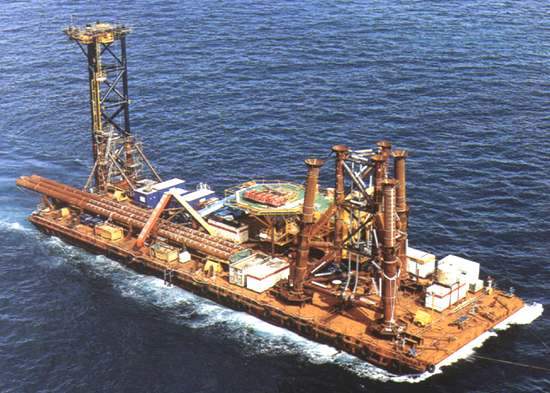Wonnich lies in Licence TL / 8 off the Western Australian coast, approximately 25km northwest of Varanus Island. The field contains up to 214 petajoules of gas at a 50% probability level and 4.1 million barrels of condensate.
The project was executed by a joint venture formed by three companies. Apache Northwest Pty Ltd is the operator of the field with a 68.5% stake, Kufpec Australia and Tap (Harriet) Pty hold 19.3% and 12.2% stakes, respectively.
The Wonnich 1 discovery well was drilled in August 1995. In order to delineate the reservoir, Apache carried out back-to-back drilling of the Wonnich-2 and 3 appraisal wells in August 1997.
Wonnich platform
Wonnich is developed by an unmanned platform, tied back to production facilities at Varanus Island, 31km away, from which the platform is remotely operated. The field’s well-head pressure is sufficiently high to permit a flow of the wellstream to the island without the need for compression or pumping.
The three-leg lattice platform stands in 30m of water. The design includes a helideck, facilities for boat access and a platform crane. It incorporates chemical-injection facilities for corrosion inhibition and a utility gas system. There is a vent-collection system with a cold vent, an open-drain system and a closed-drain system with pump disposal to export pipelines. The platform-control system consists of automation for remote control and houses a solar and TEG direct-current power system.
The platform consists of two decks. Inside it has the necessary facilities for one producing well and the additional capacity for three spare slots for the potential tie-in of future wells. There are two production manifolds, as well as provision for a third riser.
The top of the structure stands 55m above the seabed. The topside is 115t, while the lower and upper substructure are 335t. The main piles and insert piles weigh 195t, giving a total weight of 645t.
The platform and pipeline for Wonnich are designed to produce up to 120 terajoules (tj) per day and the field is producing at its designed operating level of around AUS$0.80 per day.
The jacket was built in two parts: an upper parallel-sided structure and a lower substructure including the pile guides. A parallel tri-leg lattice structure was preferred to the more common single tubular design. It was based on the gas-gatherer concept, developed by Brown & Root, for the North Sea.
Using a two-part substructure afforded the operators a significant increase of flexibility for installation, with either a conventional crane barge or a jack-up drill rig.
Drilling and discovery
The drilling over the first well, Wonnich Deep-1, was carried out in 2007. The well was drilled using the Wonnich platform. While drilling, the well penetrated the upper Jurassic Dupy Sandstone interval.
The drilling led to the discovery of additional gas in two zones during the first quarter of 2007, however, production from the platform and gas production from W-1 well was affected because of safety requirements.
The drilling of the well was held temporarily because of cyclone evacuations and mechanical problems. With the penetration of flag formation, the Wonnich Deep-1H well came onstream in July 2007.
Field development and fabrication
The conceptual engineering studies for the field development were carried out by Brown & Root. The fabrication contract was awarded to BARBOS, a joint venture between Brown & Root and BOS Australia.
Fabrication was carried out at BOS Australia’s Kwinana yard and completed at the Jervoise Bay offshore projects facility in February 1999 and loaded out in March that year.
The platform components were transported to Jervoise Bay for final assembly, then loaded onboard the Jaya transport barge.
On arrival at the TL / 8 site, the transport barge was manoeuvred under the Ensco 56 jack-up drill rig cantilever deck and secured by a four-point mooring system. The structure was unloaded using power from the jack-up rig’s draw works.
This project set an Australian water depth record for installation with a jack-up drilling rig.
The Ensco 56 was also used for the drilling and setting of the piled foundations. These were drilled on a batter with a subsea deflector frame to minimise movements of the jack-up drilling rig cantilever deck.
Pipeline to Varanus
The export system consists of two 31km-long, 8in-diameter pipelines, connecting the platform to Varanus Island. The well-stream flows to the island without any treatment other than the injection of corrosion inhibitor, which is required due to the moderately high carbon dioxide content of the gas.








